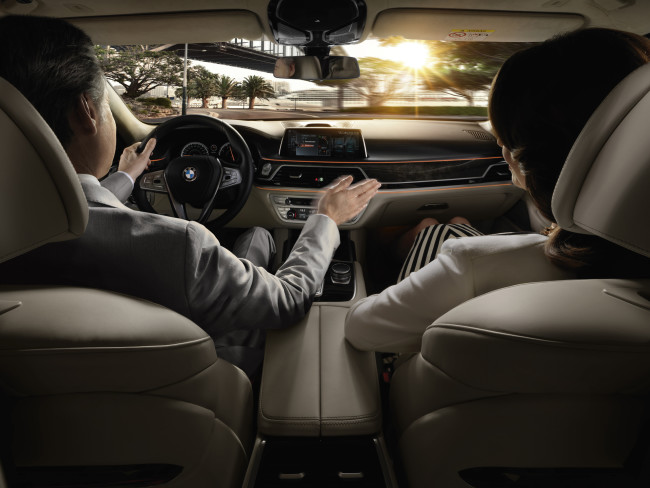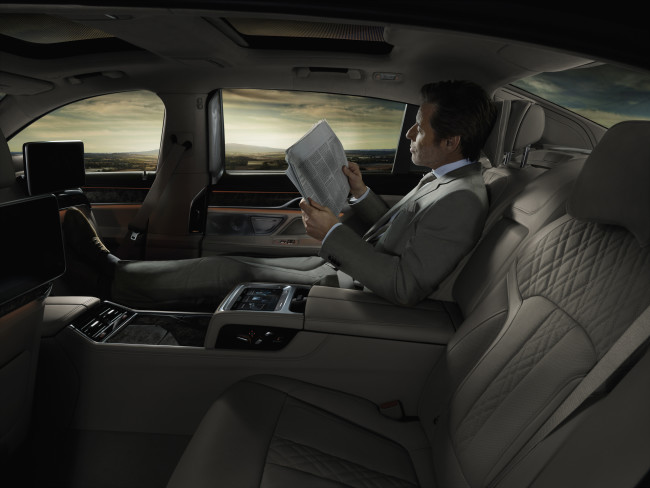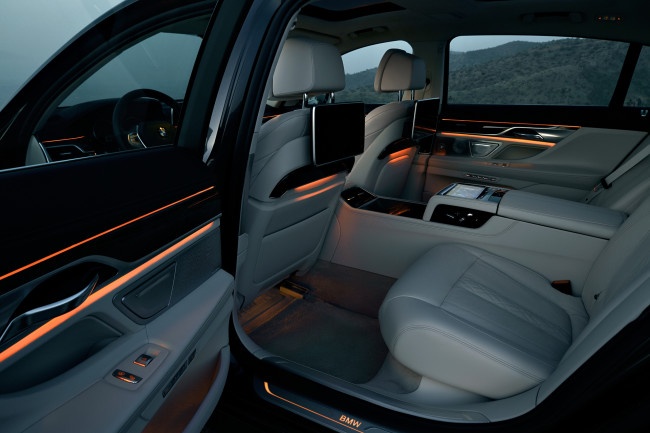BMW have just unveiled the all-new 2016 7 Series. The 2016 7 Series marks the sixth generation of the marque’s flagship. Make no mistake, this is no mild refresh; the 2016 7 Series is a whopping 86 kilograms (or 190 lb) lighter than its predecessor and features a wealth of new and improved onboard technology.
Most of the weight savings are made possible due to BMW’s EfficientLightweight thinking – essentially, the use of carbon-fibre reinforced plastic in combination with ultra-high tensile steel and aluminum. The ‘Carbon Core’ passenger cell technology is based on tech from the futuristic i cars (i8 and i3) and the 7 Series will be the first car to take advantage of BMW’s mass-produced CFRP with steel and aluminum combination.
A large part of a vehicle’s handling dynamics can be attributed to unsprung weight, and the 7 Series’s diet results in aluminum doors and trunk lid for the first time. The scorched earth approach to the lightening of the car also features lighter suspension, brakes, wheels, insulation, sound-deadening materials equalling unsprung weight reduction by up to 15 percent while lowering the 7 Series’ centre of gravity and maintaining the ever-important 50:50 weight distribution.
Engine options available at launch for the 2016 MYs feature something for every type of flagship buyer. More engine options for Canada will most likely be available as well. First up is the redeveloped 4.4L twin-turbo V8 powering the 750i xDrive. The new twin-scroll turbos – featuring trick flow-separated, bank-specific exhaust manifolds made from thin-wall castings – have been placed within the V between the banks of cylinders for weight balance and quick spool time. Engine efficiency is increased with a change in the compression ratio bump from 10.0:1 to 10.5:1.
The optimized engine cooling concept with separate flows through the cylinder heads and cylinder liners, includes a map-controlled coolant pump. The intake manifold has been partially integrated into the cylinder head allowing air-flow resistance to be decreased and maximizing air-flow volume – this is a first in a production car and BMW claims the 445-hp V8’s efficiency has been greatly improved with the newly designed V8.
Putting all that power to the ground comes by way of the new intelligent xDrive system that also features some efficiency updates, one of which includes an optimized oil supply for the transfer case.
New for 2016 is the addition of the 740e xDrive plug-in hybrid. The 2016 7 Series PHEV also borrows technology from the i cars and and combines a 2.0L turbo engine and an electric drive unit integrated into the eight-speed Steptronic transmission. Energy for the electric motor comes by way of a lithium-ion high-voltage battery (which can be recharged by connecting to any standard domestic power socket, a BMW i Wallbox or a public charging station) housed underneath the rear seat where it is particularly well protected in the event of a crash. In the Auto eDrive basic setting, the engine’s power is boosted to notable effect by the electric drive when accelerating.
With the Max eDrive mode engaged, the BMW 740e xDrive is able to run purely on electric power, meaning zero local emissions at speeds of up to 120 km/h for a maximum range of 37 kilometres.
More trick additions include a driver-selectable Battery Control mode, which raises or maintains the high-voltage battery’s state of charge so that electrical power can be deliberately conserved. For example, when route guidance is active in the navigation system, the predictive power management function calculates a trip-specific strategy for electric driving through to the entered destination.
The standard-equipment ZF eight-speed Sport Automatic Steptronic transmission, boosts efficiency by way of a wider ratio spread and reduced weight. A new transmission control system makes for more comfortable shifting and allows the transmission to be linked up with the standard Navigation system. The navigation-data-based shift strategy means that the gear selection can be adapted to the driving situation and the route profile even if route guidance has not been set. Shifting characteristics are adjusted in accordance with the selected driving mode, so that the emphasis can be placed on both driving comfort and sportiness. Flappy paddle shifters are standard as is launch control.
The no-cruise control, no-traction control, no-stability control, sanctimonious purist in me that so revered the manual-transmission 7 Series in the original Transporter is dying with each newfangled auto-tech innovation – but fascinated with the technology behind the new 7 Series.
Added features to improve efficiency include Brake Energy Regeneration and the Auto Start-Stop function do their part as well. Activating the ECO PRO mode with the Driving Dynamics Control switch allows use of the coasting function which decouples (every time I hear that word I think of Gwyneth Paltrow and Coldplay dude) the powertrain in coasting phases while travelling at speeds between 50-160 km/h. This mode’s range of new functions are now individually programmable for the first time and include efficiency-oriented operation of comfort functions making it easier and safer to make adjustments; efficiency tips; as well as the Route-Ahead Assistant, which gives recommendations for an efficient driving style based on real-time navigation data and updates.
iDrive 5.0 is available to augment the standard navigation system, featuring your choice of voice commands, touch commands, and standard Gesture Control – premiering in the flagship 7 Series. Gesture Control makes use of 3D sensors in the vicinity of centre console. With pre-selected hand movements near the centre console, the driver can issue commands to the 7 Series – it’s a good thing I’ve been practicing my Jedi mind tricks and gestures. These Obi-Wan-like gestures can adjust the audio volume control, accept or reject incoming phone calls and more. There is also space for a customizable gesture whose associated function can be yours to select from a suite of possible functions – like navigation to the home address or deactivation of the screen. This is one gizmo I can’t wait to play with. As a Star Wars ultra-ultra-fanboy, I can only imagine taking a fellow Star Wars fan out on a first date in the 7, and pulling up to their place to drop them off – then proceed to turn the dome lights on with a flick, the music down with another flick, and then… oh, back to the car.
While the new 7 Series is the largest sedan BMW has ever produced, the long-wheelbase-only 7 Series is only an inch longer than its predecessor at 206.6 inches. Wheelbase and width is unchanged at 124.6 inches for wheelbase and 74.9 inches for the width. Even with only a one-inch increase in length, BMW is claiming best-in-class rear legroom at 44.4 inches – a tenth of an inch more than the current 7.
While the dimensions remain very close to the last-gen 7, the interior outclasses it. The front passenger seat can slide forward and folded, allowing a lucky rear passenger to take advantage of the new pop-out footrest and optional 42.5-degree seat incline – available as part of the Rear Executive Lounge Seating Package. This proves the old saying, “You can live in a car, but you can’t drive your house”.
There’s only so much we can glean from a press release and all I can say is that I’m very, very excited to play with all the new gadgets and toys in the flagship sedan once we get our hands on one. I can already tell I’ll be spending several hours playing around with all the 445+ hp the 7 Series has to offer in 2016.
Pricing for Canada has not yet been announced but be sure we’ll have it up as soon as we can. For now, check out the pictures – especially the gorgeous interior.

































































































